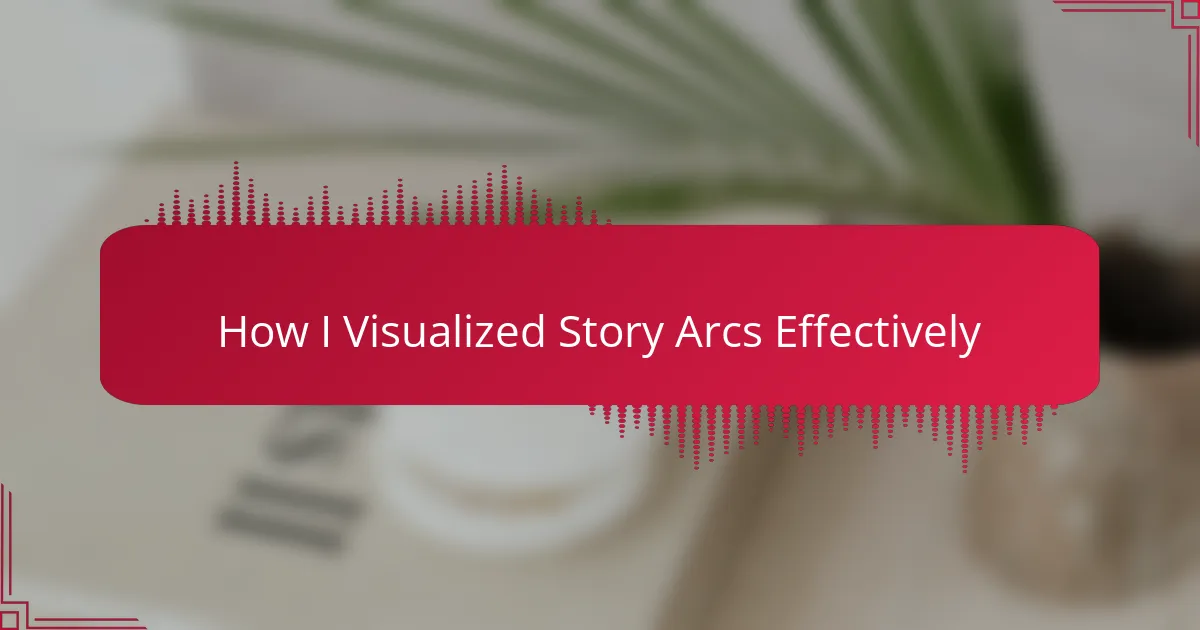Key takeaways
- Understanding story arcs involves key stages: Exposition, Rising Action, Climax, Falling Action, and Resolution, which guide narrative structure and character development.
- Visual storytelling enhances engagement and emotional connection, allowing readers to interpret narratives through images as well as text.
- Utilizing tools like Scrivener and techniques such as color-coding and storyboarding can significantly improve the organization and visualization of story arcs.
- Collaboration with other creators can provide fresh perspectives, enhancing the storytelling process and fostering creativity within the community.
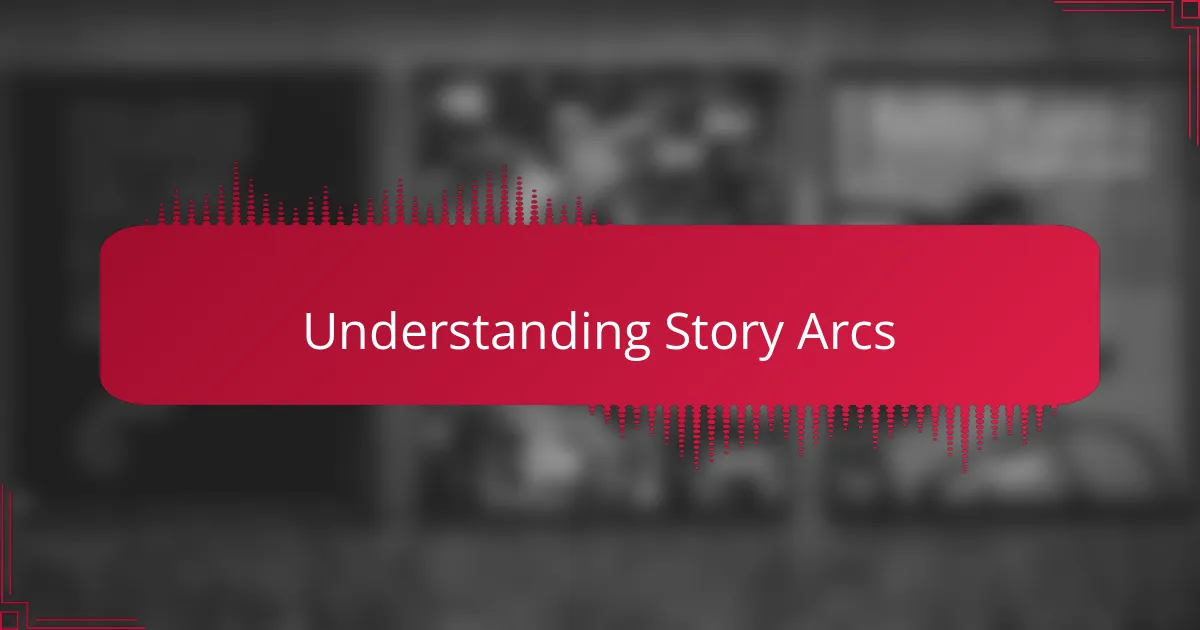
Understanding Story Arcs
Understanding story arcs is crucial for creating engaging narratives in comic books. When I first started writing, I realized that a compelling story arc not only guides character development but also keeps readers invested in the storyline. Think of it as the emotional journey you want your audience to embark on—every peak and valley matters.
I’ve found that breaking down the journey into clear stages helps in crafting a narrative that resonates. Visualizing these stages assists me in pacing the story and maintaining tension. Here are some essential elements to consider when structuring your story arcs:
- Exposition: Set the scene and introduce characters; this is your chance to hook the reader.
- Rising Action: Build tension with conflicts and obstacles that your characters must face.
- Climax: This is the turning point; it’s where emotions peak, and everything changes.
- Falling Action: Address the aftermath; show how the characters and world respond to the climax.
- Resolution: Wrap up loose ends and provide closure, leaving your readers satisfied.
Reflecting back, I’ve adopted this structured approach over time, and it’s transformed how I craft my stories, making them more engaging and coherent.

Importance of Visual Storytelling
Visual storytelling is an essential element in the comic book medium because it allows authors to convey complex narratives and emotions without relying solely on text. I remember the moment I realized the power of a single image; it was during a comic workshop when a fellow author showcased a silent panel that captured an entire range of feelings. That stark visual spoke volumes, illustrating the character’s inner turmoil and making the reader pause to reflect on their own experiences.
Effective visual storytelling not only engages readers but also enhances their understanding of the plot and character development. I’ve found that a well-placed image can evoke emotions far more effectively than words can. When I craft story arcs, I focus on how each panel contributes to the broader narrative, ensuring that my visuals resonate with the audience on a deeper level.
- Engages the audience emotionally through relatable visuals.
- Enhances character development by showing rather than telling.
- Creates a dynamic narrative flow that can captivate readers.
- Encourages readers to interpret and connect with the story personally.
- Complements the dialogue by adding layers of meaning to the narrative.

Techniques for Visualizing Arcs
When visualizing story arcs, I find that breaking down the narrative into distinct segments can greatly enhance clarity. For instance, I often sketch out key moments in my storyline on a timeline. This approach helps me see how each event connects emotionally, allowing me to ensure that the pacing feels right as well.
Another technique I love is using color-coded notes for different themes or character arcs. Each color represents an emotion or plot element, making it easier to track how they evolve throughout the story. Once, while working on a crucial scene, I noticed that my hero’s journey was feeling disjointed. The colors visually pointed out where I needed to strengthen connections, which ultimately made the entire narrative more cohesive.
- Create a timeline to map out key events.
- Use color-coding to represent different themes and character emotions.
- Sketch or storyboard pivotal moments to visualize action and pacing.
- Incorporate mind maps to explore character relationships and plot links.
- Regularly revisit and adjust your visual aids as your story evolves.
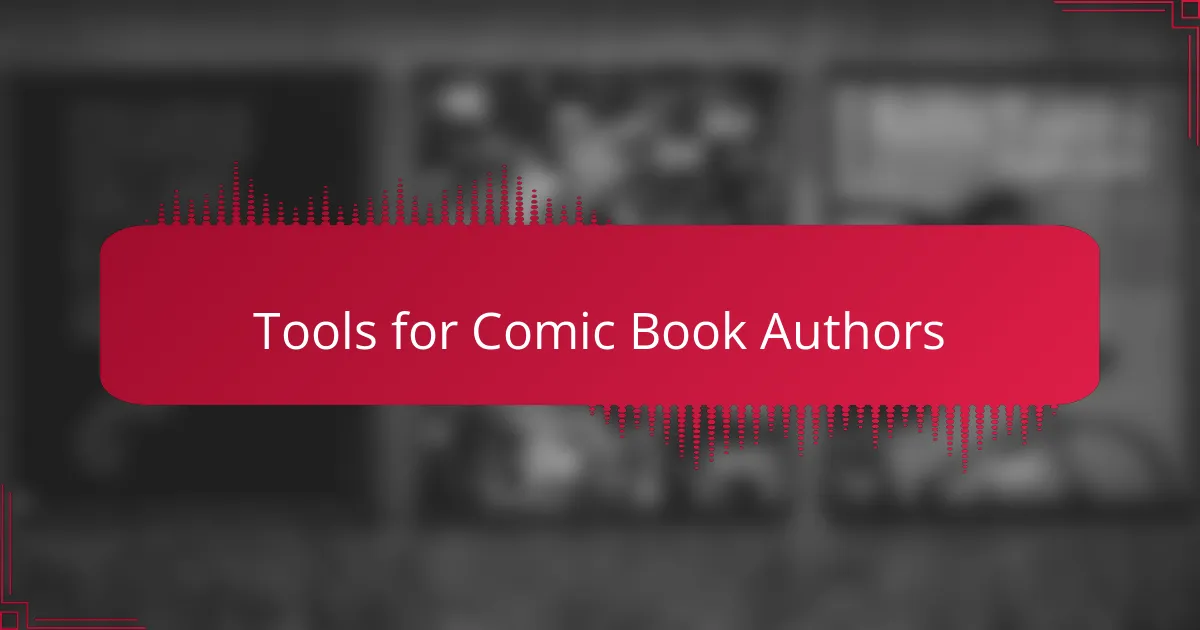
Tools for Comic Book Authors
When it comes to crafting compelling story arcs in comic books, I have found that the right tools can make all the difference. My go-to tool is Scrivener. This software’s outline feature allows me to map out my story arcs visually, helping me keep track of character development and plot progression. I remember the first time I used it; it felt like a weight had lifted, allowing my ideas to flow seamlessly without losing sight of the bigger picture.
Additionally, engaging with communities like DeviantArt or Tumblr can also be incredibly beneficial. Seeing how other creators visualize their stories has provided me with fresh perspectives. They often share their own tools and methods, which inspired me to experiment with character relationship charts, making the connections between my characters clearer. This collaborative spirit reinforces the creativity in our art form, pushing us all to evolve.
Tools for Comic Book Authors:
- Scrivener: Excellent for organizing scripts and outlines.
- Milanote: Visual brainstorming and storyboarding tool that keeps ideas in one place.
- Trello: Great for tracking progress and deadlines.
- Procreate: For artists looking to sketch and visualize scenes directly.
- Evernote: Perfect for jotting down inspiration and links to resources on-the-go.
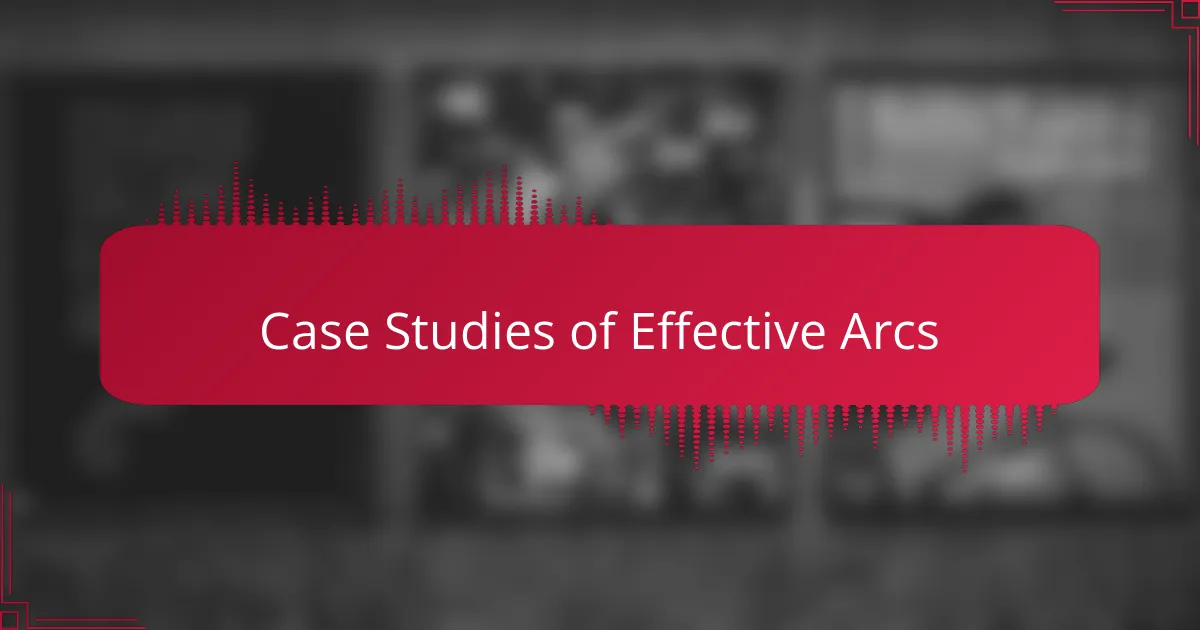
Case Studies of Effective Arcs
When analyzing effective story arcs in comics, two notable examples come to mind: “Spider-Man: Year One” and “Maus” by Art Spiegelman. In “Spider-Man: Year One,” Peter Parker’s transformation from a socially awkward teenager to a superhero is a classic, coming-of-age story that resonates with many readers, including myself. I recall feeling a deep connection to his struggles, which made his eventual triumph feel all the more significant.
On the other hand, “Maus” delivers a profound emotional punch by intertwining personal history with broader themes of trauma and survival. The way Spiegelman uses anthropomorphism to depict characters creates a unique visual experience that enhances the narrative. It helped me appreciate the power of visual storytelling, where art and text coalesce to convey complex emotions.
These examples highlight how good arcs can evoke feelings and foster a connection with the audience, reminding us of our own journeys through challenges.
| Comic Title | Type of Arc |
|---|---|
| Spider-Man: Year One | Coming-of-Age |
| Maus | Historical and Emotional |
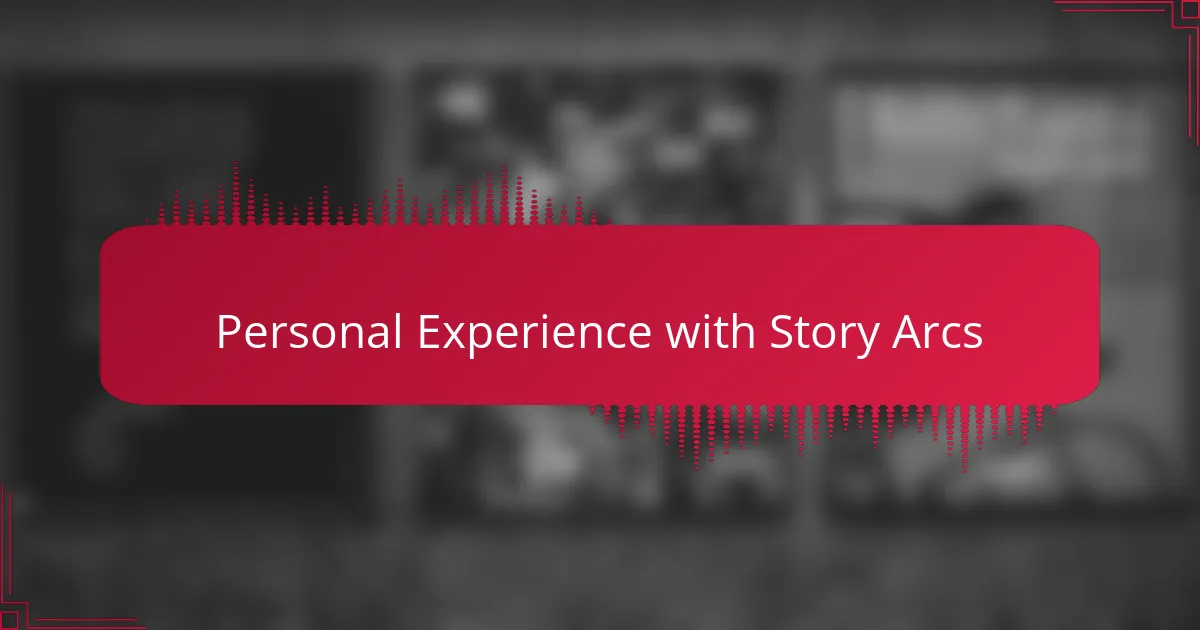
Personal Experience with Story Arcs
When I first started crafting story arcs, I struggled to visualize how each character’s journey would connect to the overall narrative. I remember feeling overwhelmed by the complexity of weaving various threads together, especially when trying to maintain emotional depth. It was through sketching visual maps that I found clarity; seeing scenes unfold in front of me really helped me understand the flow of the story.
Over time, I developed a more structured approach to designing story arcs. This not only enhanced my confidence but also allowed me to create richer character development. I began to realize that each arc is like a roller coaster, with its ups and downs creating the emotional highs and lows that keep readers engaged.
Here’s a comparison of traditional story arcs versus my visualized approach:
| Traditional Story Arcs | Visualized Story Arcs |
|---|---|
| Linear progression | Dynamic exploration |
| Focus on plot points | Emphasis on emotional journey |
| Character arcs often follow a formula | Unique character depths tailored to story |
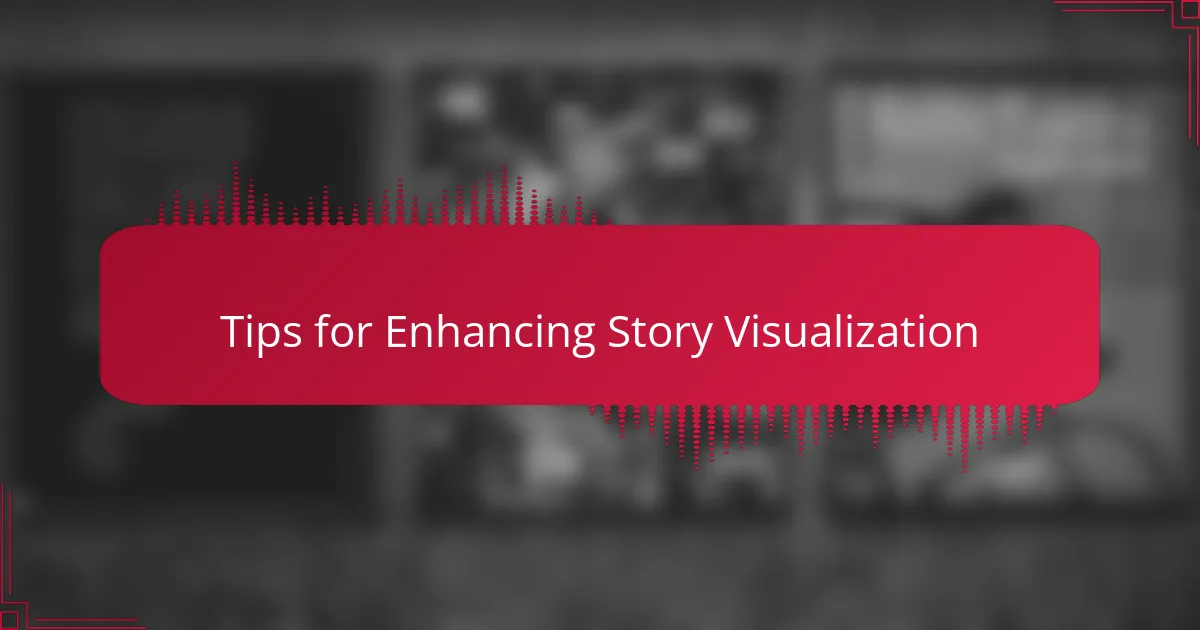
Tips for Enhancing Story Visualization
Visualizing your story arcs can be like creating a map for an uncharted territory. One technique that really helped me is to sketch character development in stages. For example, imagining where a character starts and how they evolve toward their climax can clarify the emotional highs and lows. I’ve often found that physically moving their positions on paper simulates the emotional shifts they experience, enhancing my narrative flow.
I also like to use storyboards to visualize key scenes. I remember working on a pivotal moment where the protagonist faced a tough decision. By drawing out the different outcomes, I was able to see the branching paths of the narrative. This not only helped me choose the most powerful option but also deepened my understanding of the character’s motivations. Have you ever tried to visualize a tough decision in your story? It can really change how you perceive the arc yourself!
Another approach I find effective is discussing my arcs with other creators. Collaboration brings fresh perspectives that I might overlook. For instance, during a recent brainstorming session, a fellow writer pointed out thematic connections between characters that I hadn’t fully realized. That external feedback was invaluable; it reminded me that storytelling is a community effort, often enriched by sharing our ideas and visualizations with each other. Don’t you think inviting others into the process can spark new inspiration?
